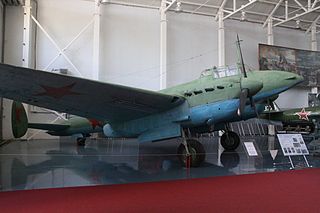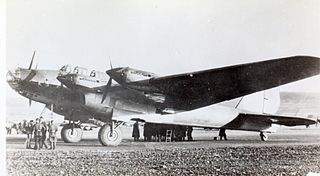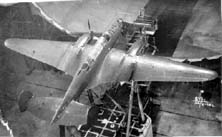
The Sukhoi Su-2 is a Soviet reconnaissance and light bomber aircraft used in the early stages of World War II. It was the first airplane designed by Pavel Sukhoi. The basic design received an engine and armament upgrade (Su-4) and was modified for the ground-attack role (ShB).

The Mikoyan-Gurevich MiG-3 is a Soviet fighter-interceptor used during World War II. It was a development of the MiG-1 by the OKO of Zavod (Factory) No. 1 in Moscow to remedy problems found during the MiG-1's development and operations. It replaced the MiG-1 on the production line at Factory No. 1 on 20 December 1940 and was built in large numbers during 1941 before Factory No. 1 was converted to build the Ilyushin Il-2.

The Petlyakov Pe-2 was a Soviet twin-engine dive bomber used during World War II. One of the outstanding tactical attack aircraft of the war, it also proved successful as a heavy fighter, as a night fighter and as a reconnaissance aircraft. The Pe-2 was, numerically, the most important Soviet bomber of World War II, at their peak comprising 75% of the Soviet twin-engine bomber force. The Soviets manufactured Pe-2s in greater numbers during the war than any other twin-engine combat aircraft except for the German Junkers Ju 88 and the British Vickers Wellington. Several communist air forces flew the type after the war, when it became known by the NATO reporting name Buck.
The Tupolev Tu-70 was a Soviet passenger variant of the Tu-4 bomber, an unlicensed, reverse engineered copy of the Boeing B-29 Superfortress. Designed immediately after the end of World War II, it used a number of components from Boeing B-29s that had made emergency landings in the Soviet Union after bombing Japan. It had the first pressurized fuselage in the Soviet Union and first flew on 27 November 1946. The aircraft was successfully tested, recommended for serial production, but ultimately not produced because of more pressing military orders and because Aeroflot had no requirement for such an aircraft. A military cargo aircraft version was the Tupolev Tu-75.

The Tupolev Tu-14, was a Soviet twinjet light bomber derived from the Tupolev '73', the failed competitor to the Ilyushin Il-28 'Beagle'. It was used as a torpedo bomber by the mine-torpedo regiments of Soviet Naval Aviation between 1952–1959 and exported to the People's Republic of China.
The Tupolev ANT-7, known by the VVS as the Tupolev R-6, was a reconnaissance aircraft and escort fighter of the Soviet Union. The R-6 traces its roots back to early 1928 when the Soviet Air Force needed a long-range multirole aircraft. The requirements were that it could be used for long-range transport, defensive patrolling, reconnaissance, light bombing and torpedo attack.

The Petlyakov Pe-8 was a Soviet heavy bomber designed before World War II, and the only four-engine bomber the USSR built during the war. Produced in limited numbers, it was used to bomb Berlin in August 1941. It was also used for so-called "morale raids" designed to raise the spirit of the Soviet people by exposing Axis vulnerabilities. Its primary mission, however, was to attack German airfields, rail yards and other rear-area facilities at night, although one was used to fly the People's Commissar of Foreign Affairs Vyacheslav Molotov from Moscow to the United States in 1942.

The Tupolev Tu-2 is a twin-engined Soviet high-speed daylight and frontline bomber aircraft used during World War II. The Tu-2 was tailored to meet a requirement for a high-speed bomber or dive-bomber, with a large internal bomb load and speed similar to that of a single-seat fighter. Designed to challenge the German Junkers Ju 88, the Tu-2 proved comparable and was produced in torpedo, interceptor and reconnaissance versions. The Tu-2 was an effective combat aircraft and it played a key role in the final offensives of the Red Army.

The Yermolayev Yer-2 was a long-range Soviet medium bomber used during World War II. It was developed from the Bartini Stal-7 prototype airliner before the war. It was used to bomb Berlin from airbases in Estonia after Operation Barbarossa began in 1941. Production was terminated in August 1941 to allow the factory to concentrate on building higher-priority Ilyushin Il-2 ground-attack aircraft, but was restarted at the end of 1943 with new, fuel-efficient, Charomskiy ACh-30B aircraft diesel engines.

The Yakovlev Yak-2 was a short-range Soviet light bomber/reconnaissance aircraft used during World War II. It was produced in small numbers, and most of them were destroyed during the opening stages of Operation Barbarossa.

The Tupolev ANT-40, also known by its service name Tupolev SB and development co-name TsAGI-40, was a high speed twin-engined three-seat monoplane bomber, first flown in 1934. The Tupolev design was advanced but lacked refinement, much to the dismay of crews, maintenance personnel, and Stalin, who pointed out that "there are no trivialities in aviation".

The Mikoyan-Gurevich DIS was a prototype Soviet heavy fighter of World War II, envisioned to serve primarily in the escort fighter role. The service designation MiG-5 was reserved for the production version of the aircraft. Competing designs in the USSR included the Grushin Gr-1, Polikarpov TIS and Tairov Ta-3.

The Petlyakov Pe-3 was the long-range heavy fighter version of the successful Petlyakov Pe-2 high-speed dive bomber used by the Soviet Union during World War II.

The CA-11 Woomera was a production development of the earlier CA-4 Wackett Bomber prototype, and was an Australian torpedo and dive bomber aircraft that was designed and constructed by the Commonwealth Aircraft Corporation (CAC) during World War II. The order for the Woomera was cancelled before it became operational with the Royal Australian Air Force (RAAF).

The Tupolev Tu-12 was an experimental Soviet jet-powered medium bomber developed from the successful piston-engined Tupolev Tu-2 bomber after the end of World War II. It was designed as an interim aircraft to familiarize Tupolev and the Soviet Air Forces (VVS) with the issues involved with jet-engined bombers.
The Tupolev DB-1 (ANT-36) was a Soviet long-range bomber developed in the 1930s. It was developed from the Tupolev ANT-25 distance record-breaking aircraft. Development was prolonged and it was recognized as obsolete by the time it was in production. Only eighteen were built and all were withdrawn from service in 1937.

The Tupolev Tu-1 was a prototype Soviet night fighter variant of the Tupolev Tu-2 medium bomber that first flew after the end of World War II. It was cancelled when its experimental Mikulin AM-43V engines reached the end of their service life.

The Tupolev Tu-8, OKB designation '69', was a long-range variant of the Soviet Tupolev Tu-2 medium bomber that first flew after the end of World War II. It was canceled when it proved to be unstable, structurally unsound and its generators were not strong enough to fully power its gun turrets. With the advent of jet-powered bombers, Soviet military planners decided that it simply was not worth devoting the necessary resources to fix its numerous problems.

The Polikarpov SPB (D) (Skorostnoy Pikiruyushchy Bombardirovshchik (Dalnost)—High Speed Dive Bomber (Distance)) was a Soviet twin-engined dive bomber designed before World War II. A single prototype and five pre-production aircraft were built, but two crashed and the program was cancelled in favor of the Petlyakov Pe-2.
The Tupolev ANT-41 was a prototype Soviet twin-engined torpedo-bomber of the 1930s. A single prototype was built, which was destroyed in a crash. No production followed, with the Ilyushin DB-3 serving as a torpedo bomber instead.

















